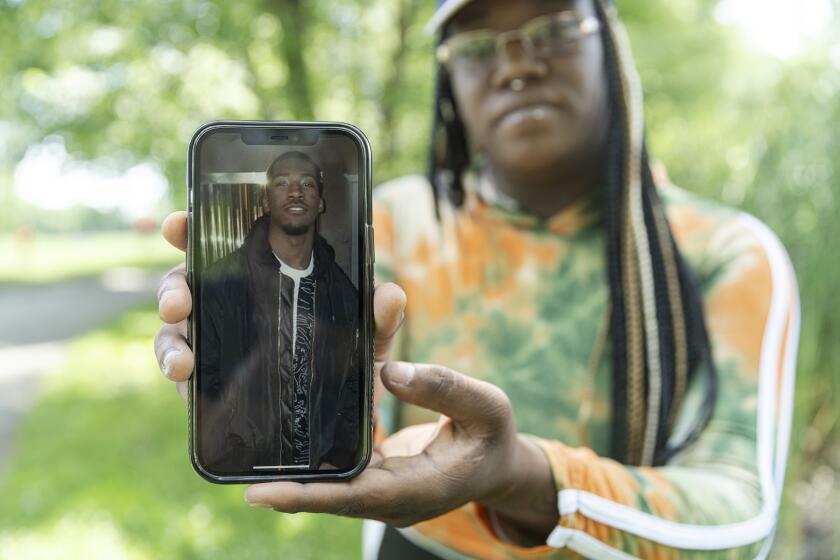On front lines of L.A.’s homicide spike, these detectives race to solve mounting caseloads
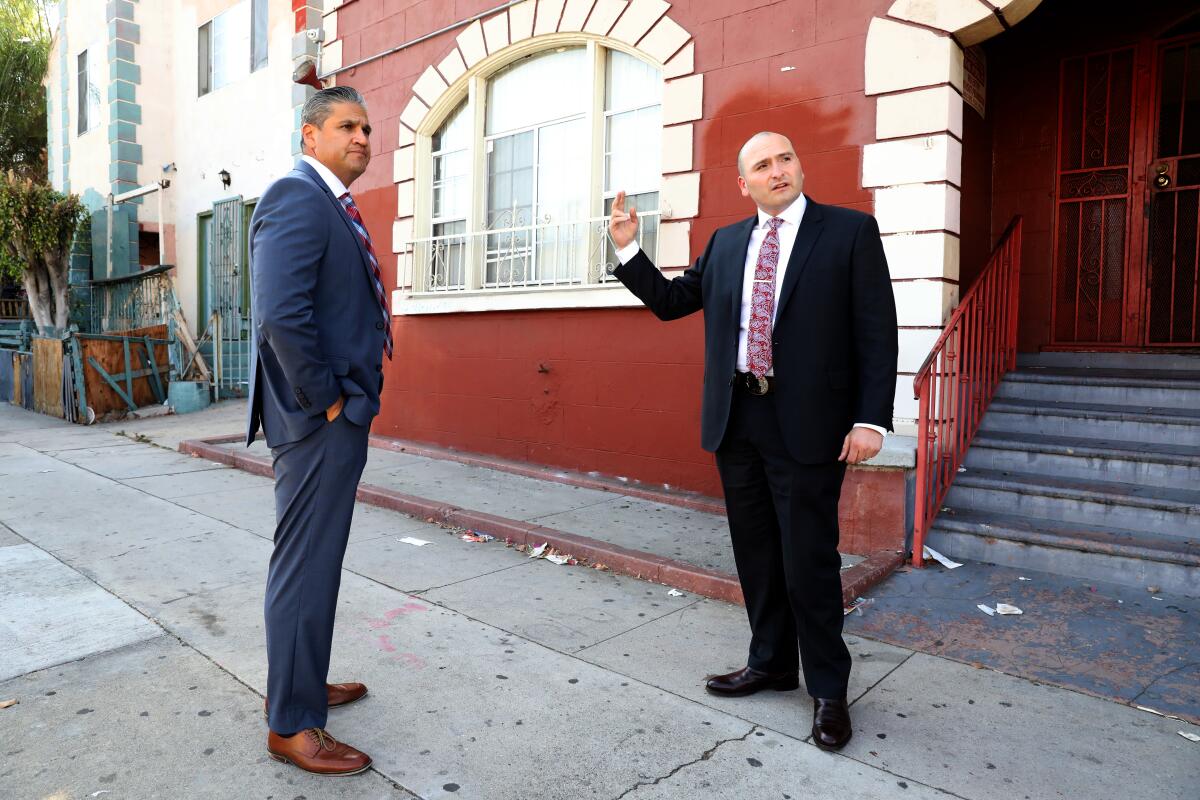
When the calls about new killings come in, often after dark and on weekends, Los Angeles homicide detectives John Meneses and Jason Sharman rush out to meet the dead.
Getting to L.A.’s bloodiest crime scenes quickly is crucial, not just because clues and firsthand accounts fade fast in neighborhoods where many are transient and gang retaliation is a constant threat, but because the next killing is always around the corner — especially now.
“You try to solve them as quickly as you can,” Sharman said, “because you know you’re going to get hit again.”
In the last 18 months, L.A.’s body count from homicides has increased far faster than it did for a decade prior, while the rate at which such crimes are being solved in some areas has dropped. Other cities across the country have experienced similar trends, and police officials and criminologists nationwide are trying to figure out why — considering factors as disparate as the economic toll of COVID-19, the closing of social services during lockdowns, and the scope and intensity of recent anti-police protests.
On the front lines of L.A.’s homicide spike, Meneses and Sharman say such macro-level theories fade into the background when they take stock of their own growing caseloads, which are full of senseless killings over petty beefs and unpaid drug debts. The primary drivers of the violence are the city’s innumerable gangs, they say, and increasingly — as either the suspect or victim — its growing homeless population.
The COVID-19 pandemic — which has kept many businesses closed and many people at home — is definitely a major factor, though analysts say the full answer is likely more complex.
Through the middle of last month, when Central Bureau Homicide had 97 killings on its 2021 books, 54 of them were considered gang-related and 37 were labeled transient-related, said Lt. Ryan Rabbett, who oversees the unit.
Reflected in those figures are gang members who are also homeless, and a startling proliferation of firearms, both in the hands of roving gang enforcers and within homeless encampments.
“We’re seeing a lot of transients with guns,” Rabbett said.
To better understand the homicide spike in L.A. since last year, The Times interviewed several homicide detectives, gang officers and supervisors about what they are seeing — and how they are coping with it amid historic scrutiny around American policing. Such access is rare, and such officers’ voices aren’t always publicly heard despite their central role in the crime fight.
They consistently lamented the increase in guns — often homemade, hard-to-trace “ghost guns” — and an increase in homeless encampments that has not only led to more disputes among encampment residents, but has created ripe targets for gang members who double as drug dealers and exploit addiction in the homeless community. As the violence has spread, they said, so have concerns from residents who see their neighborhoods slipping backward due to the economic and social impacts.
For all the recent talk of defunding the LAPD and shifting part of its budget to social service providers, the investigators also spoke of community leaders and residents desperate for solutions, eager for the killings to be solved, and supportive of more investment in the type of investigative work they do. Though surveys show many people support shifting some police funding, far fewer want police abolished — in large part because they value their role in solving violent crime.
Police officials see that value, too, and say more direct investment in solving homicides — not less — is what’s necessary to turn the tide of violence.
“I am concerned that they are burning their candles at both ends,” Rabbett said of his detectives, who are carrying substantially larger caseloads because of the increase in killings. “No matter how driven you are, you can burn out.”
Working the streets
This year through Oct. 16, there were 30 homicides in the Hollenbeck area, a 36% rise over the 22 killings there during the same period last year and a 114% increase over the 14 seen at the same point in 2019.
Sgt. Jaime Chacon, who has worked enforcement for years and now heads the area’s gang enforcement detail, said the numbers have been startling given all the strides the city and the department have made since the worst days of the 1990s, when homicides topped 1,000 a year.
As of Oct. 18, the city had seen 320 homicides this year, putting it on pace to surpass the 355 last year — which was a decade high — and potentially top 400 killings for the first time since 2006.
Chacon said there would be even more homicides on the books this year if the surgeons at L.A.’s emergency centers hadn’t gotten so skilled in recent decades at saving the lives of people riddled with bullets. Hundreds of badly wounded gunshot victims have survived this year. The number of people shot in L.A. through Oct. 9 was up nearly 22% over last year, and 48% over 2019, according to police data.
On a recent evening in Hollenbeck, Chacon drove along industrial streets that he said have become de facto neighborhoods for the transient and homeless, lined with caravans and tents. Certain stretches that are quiet during the day come alive after sundown with “gangsters setting up camp to sell narcotics” and their transient customers lining up to get their fix, Chacon said.
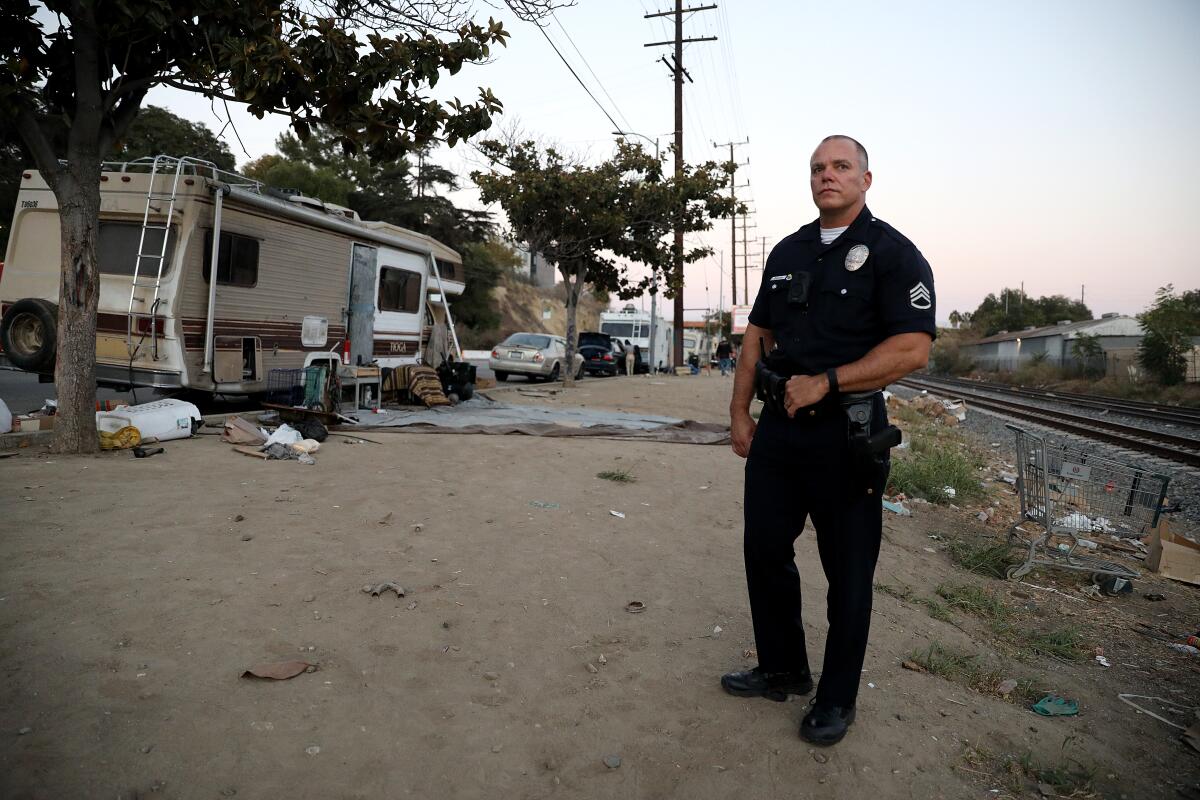
His gang enforcement officers know these stretches well, in part because they respond along with homicide detectives and other patrol officers when disputes turn violent or deadly.
“When night falls, this street is very busy,” Chacon said on one industrial stretch near the L.A. River. “It’s not just homeless, destitute people. A lot of it is run by the gangs.”
Chacon also drove through housing projects that he said are controlled by gangs and have been for generations, pointing out graffiti near playgrounds spelling out the initials of certain sets. Though LAPD officers have been accused of mislabeling some people as gang members, Chacon and outside experts on L.A.’s gang culture say there is no denying the foothold that gangs have in certain neighborhoods — and the role they play in the violence there.
At times, gangs with territories that abut one another battle over drugs and turf. At other times, they gather for celebrations — including cookouts in honor of a gang’s founding or a big homecoming of dispersed members — and take over entire housing developments, Chacon said. In the process, they intimidate residents, get into violent fights among themselves and present massive targets for their rivals, leading to gunfire, he said.
Chacon said LAPD community partnership officers who work in the neighborhoods help in easing problems, and his officers try to prevent trouble, too. He said his officers have big hearts for the communities they work in, know the gangs well, and work to help the former thrive while suppressing the influence of the latter.
But they are also frustrated, Chacon said, because they see their work being undermined by new rules — related both to the COVID-19 pandemic and the policies of L.A. County Dist. Atty. George Gascón — that have reduced sentences or eliminated bail for arrestees, letting them back on the street faster than before.
Chacon said one man, who he alleged is a gang member and who court records confirmed has been arrested on gun charges multiple times in recent months, had been a thorn in his officers’ side, and they were at their wits’ end seeing him let back out time and again.
“He’s going to keep getting a gun until he hurts someone,” Chacon said. “We can’t keep putting the same person in jail over and over and over again until he commits a violent felony.”
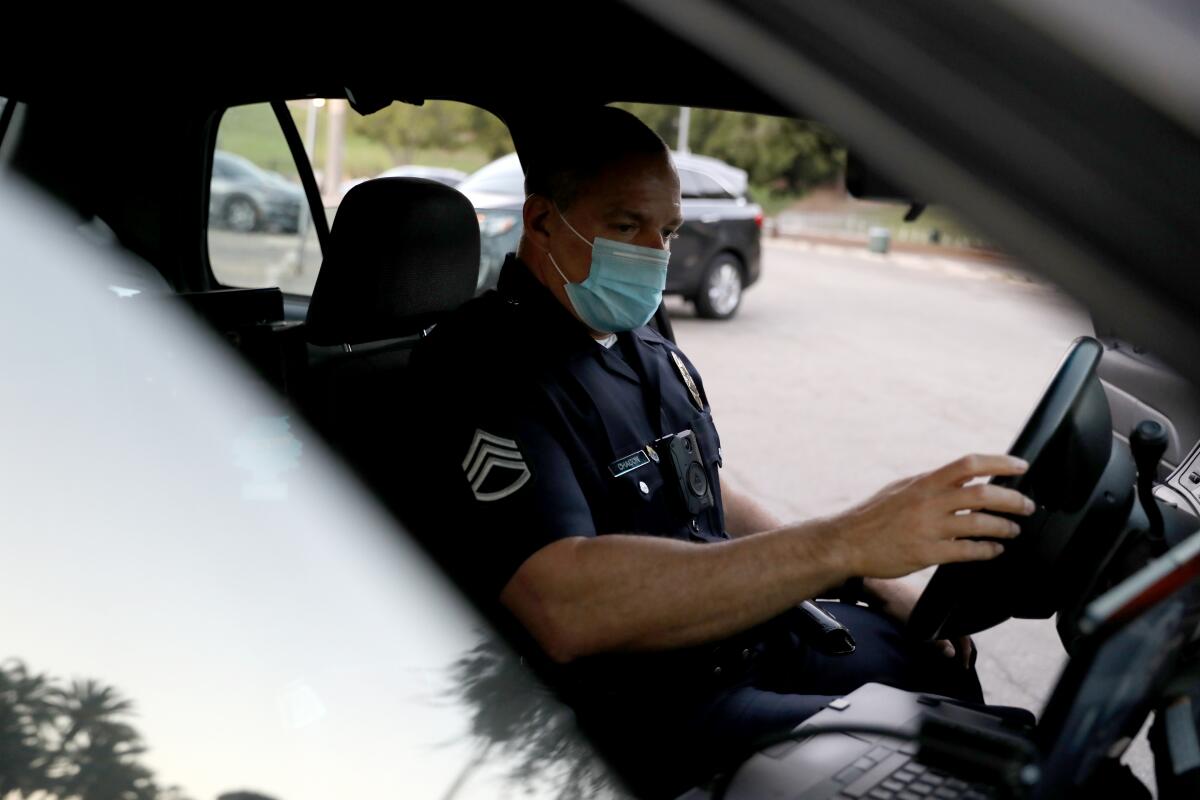
Chacon said the idea that police officers aren’t wanted in the community is simply not true in many of the neighborhoods his officers work. Residents want police officers to arrest bad guys with guns, and for those offenders to stay in prison, he said.
“There’s a lot of people who really do love and support us.”
Chasing leads
With homicide cases piling up, Meneses and Sharman said their work lives, and thus their personal lives, have gotten extremely busy.
Their families — both are married with children — know the deal, and are used to them slipping away from gatherings, leaving at night, being gone for eight hours, 16 hours or until the leads run dry.
When the detectives hit the streets, they almost always wear suits. Anyone who’s spent time in neighborhoods where killings occur with any frequency notices them pretty easily, but they are still less conspicuous than uniformed officers — which helps, they said, because few people want to be seen talking to the cops.
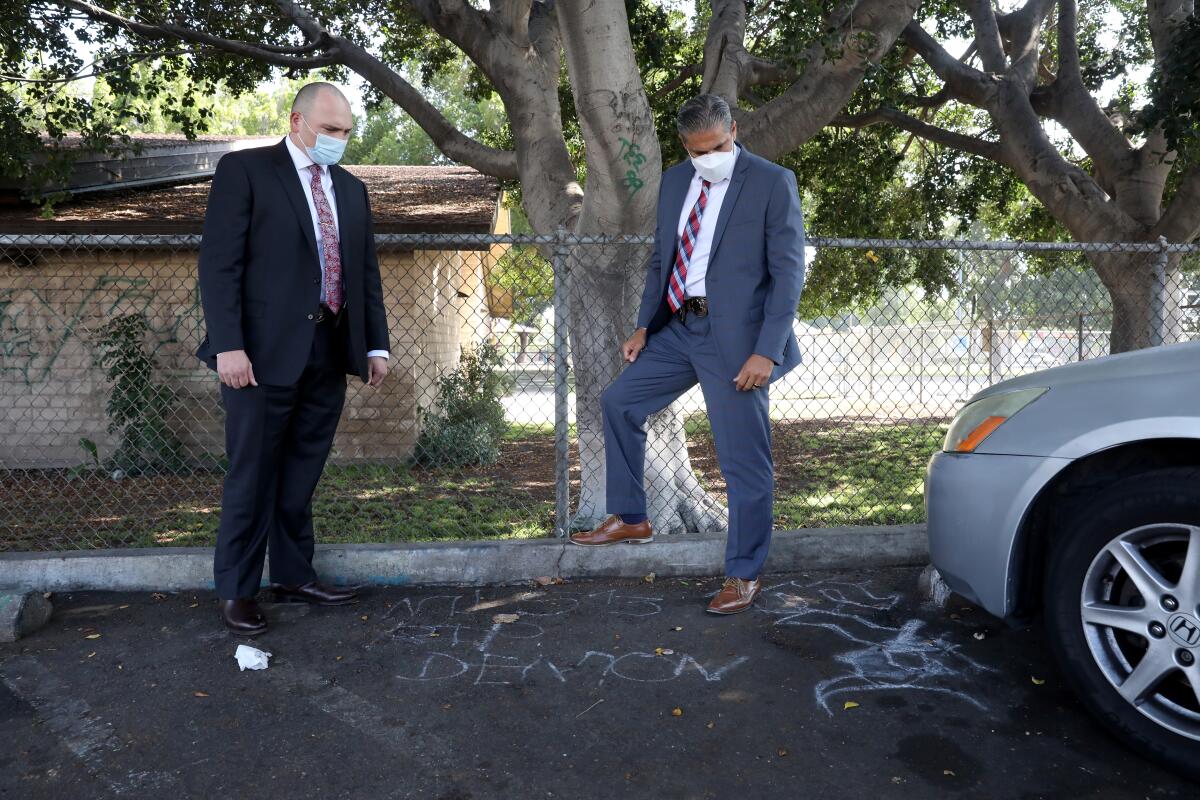
The detectives said that resistance is based more on fear than animosity, and they don’t really hear the anti-police rhetoric that other officers get. People in neighborhoods beset by violence understand the role of the detectives, and want them there, they said.
“They do want us to rid this violent behavior out here,” Sharman said.
Still, the fear makes cracking cases tough, necessitating a nuanced understanding of local gang realities and careful interactions with potential witnesses — like leaving a card to have a follow-up conversation rather than chatting on the street.
Cases involving transient or homeless people as victims or suspects, or both, can be equally challenging, for different reasons, the detectives said.
A witness who lives on the street can be especially vulnerable to retaliation, and therefore fearful of speaking up about a case whether a gang is involved or not. Transient witnesses can also be hard to reach a second time.
Within homeless encampments, where violent crimes are more frequent than ever, mental illness and substance abuse can be endemic, which makes determining a set of facts more difficult. The ability of those under the influence of alcohol or drugs to be a good witness “is kind of tarnished,” Meneses said.
The complexity of their cases, the hesitancy of some witnesses to come forward and the sheer volume of killings lately have all affected the LAPD’s homicide clearance rate — a figure calculated under a national formula that weighs arrests and other closures of past and new homicides against the total number of new cases in a given year.
According to the LAPD, the department’s citywide homicide clearance rate in 2019 stood at 76%, which was higher than the FBI-reported national average of 61.4%. In 2020, however, the LAPD’s clearance rate fell to 55%, the department said.
The declines mirrored others across the state and country. According to California Department of Justice data, the state’s overall homicide clearance rate dropped from 64.6% in 2019 to 58.9% in 2020.
LAPD officials said detectives have made strides this year in increasing arrests once more. Still, with the influx of so many new cases, the clearance rate in Central Bureau Homicide recently stood at just 53%, while in South Bureau it stood at 65% — meaning many cases are going unsolved.
Subscribers get early access to this story
We’re offering L.A. Times subscribers first access to our best journalism. Thank you for your support.
When the detectives do solve cases, it’s often with the help of officers in patrol and other specialized units working the streets.
In one recent case, Meneses and Sharman were called to a scene in Lincoln Heights, in a parking lot behind a 99 Cents Only store, where one homeless person had allegedly killed another.
The two men had allegedly been doing crystal meth with the victim’s girlfriend when the suspect — in what Sharman described as a “drug-induced psychosis” — allegedly attacked the victim with a knife that the three had been using to cut fruit.
When the suspect was found nearby, he was covered with blood and later confessed to the killing, the detectives said.
In another case in December in Boyle Heights, a man and woman were walking down the street when a car pulled up and several people got out. The woman on the street appeared to know a woman who got out of the car, and the two began arguing. Suddenly, a man who had gotten out of the car — who police said was a known gang member — pulled out a gun and fatally shot the man and the woman who’d been walking on the street, the detectives said.
“It was just cold,” Meneses said.
Enforcement officers working that night managed to stop the car, which was allegedly stolen, and recovered the gun, and the detectives were able to recover video from the scene that helped secure homicide charges against the alleged gang member, the detectives said.
For Meneses, such victories are what the long hours are all about, feeding the drive he feels “to help bring some semblance of justice to these families.”
Sharman agreed. He said his wife’s mother was murdered in Gardena when they were dating in high school, which gave him an early glimpse of the trauma such violence causes for those left behind — especially when the killer isn’t caught.
“It’s our job as investigators to bring closure to these families,” Sharman said. “That’s why I do it.”
Pushing ahead
Rabbett, the lieutenant who oversees Meneses’ and Sharman’s unit, says his team is “stretched.”
The number of new homicide cases that each of his two-detective teams had picked up this year, as of last month, was nine, he said — and that’s too many. Though his detectives “pour their heart and souls into these cases,” their effectiveness is limited by their caseload, with the amount of time they can spend on any one case dropping with each new case they take on, Rabbett said.
It’s an oft-discussed correlation in law enforcement and in homicide work, and a worrying one for him this year as L.A.’s homicides continue at an elevated rate, Rabbett said.
“If I had the ability to just give them one case, I would,” he said.
Deputy Chief Al Labrada, who commands the Central Bureau, said he has requested additional personnel from the department to work the bureau’s homicide cases — including lead detectives, but also other investigators to assist in intelligence gathering.
Homicides have skyrocketed across the country during the COVID-19 pandemic. Milwaukee has seen one of the largest spikes.
It’s not an easy ask, Labrada said, as the department is currently hundreds of officers short of its authorized force and struggling to recruit faster than attrition thins its ranks further. Still, he’s committed to the increase, he said.
Killings are incredibly time-consuming crimes to investigate, Labrada said. You have to knock on doors, conduct interviews, zero in on suspects and pull video from surveillance cameras, not only at the scene of the stabbing or shooting, but sometimes for miles around as you track a suspect’s vehicle through the streets.
Labrada said he did not know how many additional detectives he’ll be able to deploy, but that he was hoping to see backup arrive soon — not only for the sake of his overworked homicide detectives, but for the families of the victims whose deaths they are charged with solving.
“We owe it to these victims. We owe it to these families,” Labrada said. “We have to have enough people to investigate these crimes effectively.”
More to Read
Sign up for Essential California
The most important California stories and recommendations in your inbox every morning.
You may occasionally receive promotional content from the Los Angeles Times.

